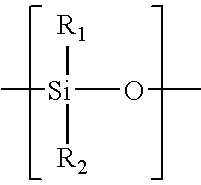Soft tissue paper having a polyhydroxy compound applied onto a surface thereof
a technology of soft tissue paper and polyhydroxy compound, which is applied in the field of soft tissue paper products having polyhydroxy compound applied thereto, can solve the problems of persistent personal hygiene problems, inability to achieve the level of cleanliness that can be achieved, and inability to effectively clean the skin, etc., to achieve the degree of softness required by consumers, and achieve the effect of reducing the number of irritants and affecting the quality of soft tissue paper
- Summary
- Abstract
- Description
- Claims
- Application Information
AI Technical Summary
Benefits of technology
Problems solved by technology
Method used
Image
Examples
example 1
[0086]A 3% by weight aqueous slurry of NSK (northern softwood Kraft) is made in a conventional re-pulper. The NSK slurry is refined, and a 2% solution of Kymene 557LX is added to the NSK stock pipe at a rate sufficient to deliver 1% Kymene 557LX by weight of the dry fibers. The absorption of the wet strength resin is enhanced by passing the treated slurry though an in-line mixer. KYMENE 557LX is supplied by Hercules Corp of Wilmington, Del. A 1% solution of carboxy methyl cellulose is added after the in-line mixer at a rate of 0.15% by weight of the dry fibers to enhance the dry strength of the fibrous structure. The aqueous slurry of NSK fibers passes through a centrifugal stock pump to aid in distributing the CMC. An aqueous dispersion of DiTallow DiMethyl Ammonium Methyl Sulfate (DTDMAMS) (170° F. / 76.6° C.) at a concentration of 1% by weight is added to the NSK stock pipe at a rate of about 0.05% by weight DTDMAMS per ton of dry fiber weight.
[0087]A 3% by weight aqueous slurry of...
example 2
[0093]The individual plies of Example 2 are made according to the process detailed in Example 1 supra. Two plies were combined with the wire side facing out. During the converting process, a surface softening agent is applied with a slot extrusion die to the outside surface of both plies. The surface softening agent is applied by component in the following sequence: silicone (i.e. MR-1003, marketed by Wacker Chemical Corporation of Adrian, Mich.) followed by one or more polyhydroxy compounds (Polyethylene glycol, Polypropylene glycol, and / or copolymers of the like marketed by BASF Corporation of Florham Park, N.J.) and / or glycerin. The polyhydroxy compound may also be mixed with glycerin (marketed by PG Chemical Company). The solution, the neat polyhydroxy or a mixture, with other polyhydroxy compounds and / or glycerin or neat glycerin, is applied to the web at a rate of 20% by weight. The plies are then bonded together with mechanical ply-bonding wheels, slit, and then folded into f...
PUM
| Property | Measurement | Unit |
|---|---|---|
| density | aaaaa | aaaaa |
| density | aaaaa | aaaaa |
| density | aaaaa | aaaaa |
Abstract
Description
Claims
Application Information
 Login to View More
Login to View More - R&D
- Intellectual Property
- Life Sciences
- Materials
- Tech Scout
- Unparalleled Data Quality
- Higher Quality Content
- 60% Fewer Hallucinations
Browse by: Latest US Patents, China's latest patents, Technical Efficacy Thesaurus, Application Domain, Technology Topic, Popular Technical Reports.
© 2025 PatSnap. All rights reserved.Legal|Privacy policy|Modern Slavery Act Transparency Statement|Sitemap|About US| Contact US: help@patsnap.com



